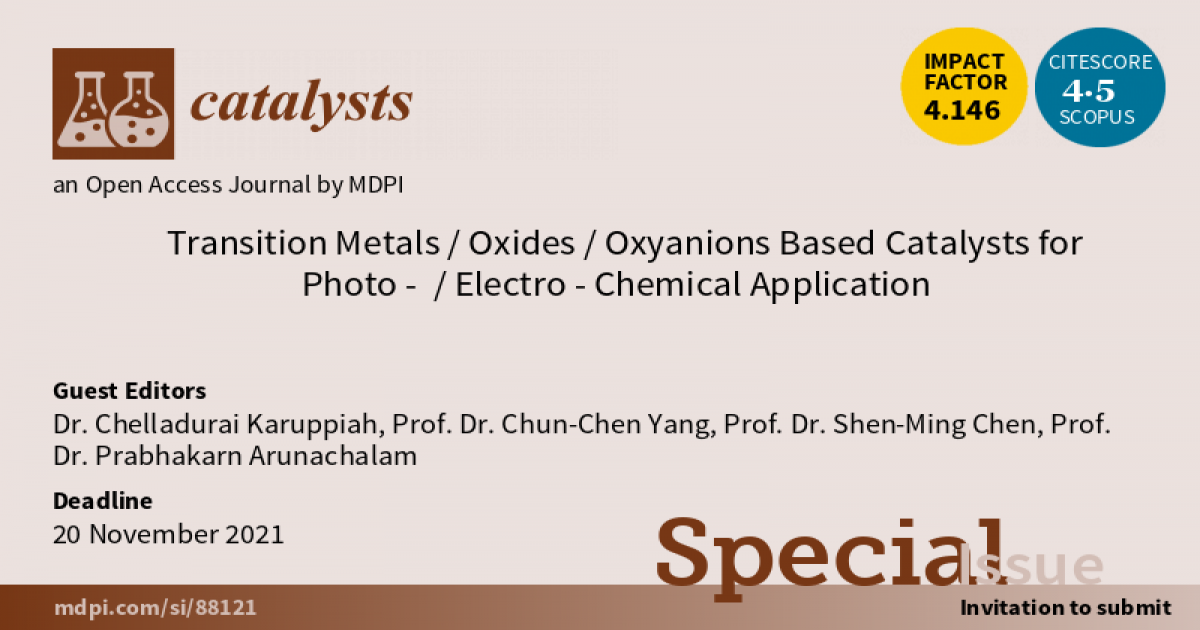- 4.0Impact Factor
- 7.6CiteScore
- 17 daysTime to First Decision
Transition Metals/Oxides/Oxyanions Based Catalysts for Photo-/Electro-Chemical Application
This special issue belongs to the section “Catalytic Materials“.
Special Issue Information
Dear Colleagues,
In recent decades, transition metal oxyanions, especially vanadate-, molybdate-, and tungsdate-based catalyst materials have been widely studied in many research fields, such as catalysis, photocatalysis, electrocatalysis, optical fibers, lasers, energy conversion and storage, water splitting, lithium-ion batteries, supercapacitors, photoluminescence, humidity sensors, etc. Several nanostructures and morphologies of these materials have also been reported including flower-like, nest-like, nanowires, nanoplates, thin films, nanorods, dendrites, doughnut-shaped microstructures, nanopowders, etc. These materials have usually been synthesized through simple and cost-effective methods such as hydro/solvothermal methods, co-precipitation methods, sonochemical methods, combustion methods, sol–gel methods, and solid-state methods. Due to their attractive unique properties, including physicochemical properties, stable crystal structure, high photostability, good catalytic convertor ability, corrosion inhibitor redox behavior, and high electronic conductivity, transition metal oxyanions have been extensively investigated in photo-/electrochemical applications.
This Special Issue aims to cover all types of metal vanadate-, molybdate-, and tungstate-based catalyst materials used in photo-/electrochemical applications. This also includes the synthesis, materials’ characterization, property evaluation, composite material synthesis, biomolecule detection, environmental/pharmaceutical pollutant detection and degradation through photo/electrocatalytic oxidations and reductions, photodegradation, electrochemical sensing, energy storage, and conversion application. The issue also concerns experimental and theoretical evaluation to understand the photo/electrocatalytic reaction kinetics of potential catalysts. Original research papers, short communications, and review articles are invited for submission.
Dr. Chelladurai Karuppiah
Prof. Dr. Chun-Chen Yang
Prof. Dr. Shen-Ming Chen
Prof. Dr. Prabhakarn Arunachalam
Guest Editors
Manuscript Submission Information
Manuscripts should be submitted online at www.mdpi.com by registering and logging in to this website. Once you are registered, click here to go to the submission form. Manuscripts can be submitted until the deadline. All submissions that pass pre-check are peer-reviewed. Accepted papers will be published continuously in the journal (as soon as accepted) and will be listed together on the special issue website. Research articles, review articles as well as short communications are invited. For planned papers, a title and short abstract (about 250 words) can be sent to the Editorial Office for assessment.
Submitted manuscripts should not have been published previously, nor be under consideration for publication elsewhere (except conference proceedings papers). All manuscripts are thoroughly refereed through a single-blind peer-review process. A guide for authors and other relevant information for submission of manuscripts is available on the Instructions for Authors page. Catalysts is an international peer-reviewed open access monthly journal published by MDPI.
Please visit the Instructions for Authors page before submitting a manuscript. The Article Processing Charge (APC) for publication in this open access journal is 2200 CHF (Swiss Francs). Submitted papers should be well formatted and use good English. Authors may use MDPI's English editing service prior to publication or during author revisions.
Keywords
- Electrocatalysis
- Photocatalysis
- Electrochemical sensor
- Photodegradation
- Detection and degradation
- Water splitting
- Energy storage and conversion materials
- Lithium-ion battery
- Sodium-ion battery
- Supercapacitor
- Hydrogen evolution reaction
- Oxygen evolution reaction
- Oxygen reduction reaction
- Environmental pollutants
- Pharmaceutical drugs

Benefits of Publishing in a Special Issue
- Ease of navigation: Grouping papers by topic helps scholars navigate broad scope journals more efficiently.
- Greater discoverability: Special Issues support the reach and impact of scientific research. Articles in Special Issues are more discoverable and cited more frequently.
- Expansion of research network: Special Issues facilitate connections among authors, fostering scientific collaborations.
- External promotion: Articles in Special Issues are often promoted through the journal's social media, increasing their visibility.
- e-Book format: Special Issues with more than 10 articles can be published as dedicated e-books, ensuring wide and rapid dissemination.

